A
Auto Express
Guest
The Ford Mustang is a brilliant sports car, and acts as a flagship for the manufacturer’s entire line-up. It’s one of the most instantly recognisable cars on the road, with sharp lines and retro touches to turn the heads of passers-by. But the Mustang isn’t just for show: the chassis is wonderfully capable and delivers brilliant handling as well as comfy ride quality.
There are some drawbacks of course: some of the interior materials are a little cheap (although an update in 2018 improved this) and the engines are extremely thirsty, but it’s hard to complain when prices start from as little as £38,000. The EcoBoost engine isn’t quite as dramatic or fast as its V8 sibling, but the difference isn’t that pronounced and it does at least cut running costs.
Few other vehicles are as eye-catching as the Mustang at this price point, nor can they offer as much engine grunt.
• Ford Mustang Convertible review
The Ford Mustang has been on sale in the UK since the latter stages of 2015, although the iconic Mustang name has existed in one form or another since the middle of the 1960s. The current model is the sixth-generation Mustang and is offered as a Fastback coupe or fabric-roofed convertible, offered in either 5.0-litre V8 GT or 2.3-litre EcoBoost guise. This line-up has helped the Mustang to become an instant hit with buyers, while an update in 2018 has helped it to maintain its appeal. A retro Mustang Bullitt model sits at the top of the range, inspired by the car that featured in the famous film of the same name.
There aren't really many rivals for the Ford Mustang in the UK. Its arch rival in the US is the Chevrolet Camaro, available here as a special order model in left-hand-drive only, so the Mustang has the market pretty much to itself. The Lexus RC F is a V8 coupe, but it's around £20,000 more expensive than the Ford, while the harder-edged BMW M2 Competition sits just above the top-spec Bullitt Mustang in the market, priced at around £50,000. The Toyota Supra is a better all-round sports car but is priced to take on pricier rivals like the Porsche Cayman.
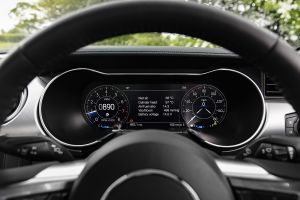
Ford Mustang V8 - dials
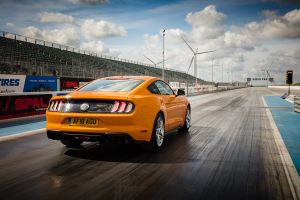
Ford Mustang V8 - rear drag strip
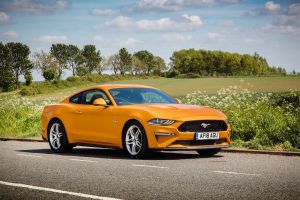
Ford Mustang V8 - front static
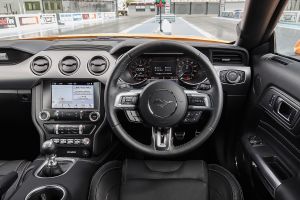
Ford Mustang V8 - dash
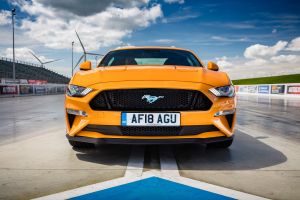
Ford Mustang V8 - full front static

Ford Mustang V8 - rear profile
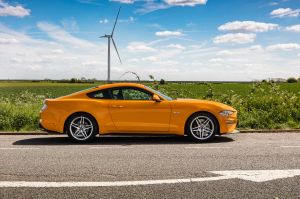
Ford Mustang V8 - side static
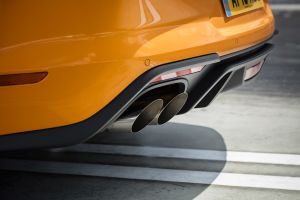
Ford Mustang V8 - exhaust
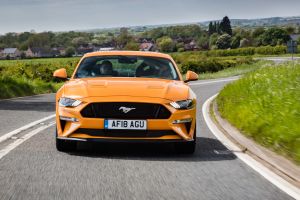
Ford Mustang V8 - full front
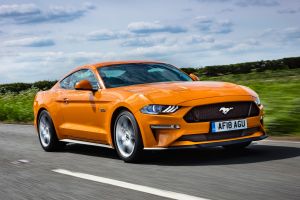
Ford Mustang V8 - front

Ford Mustang V8 - front light
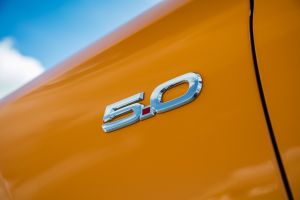
Ford Mustang V8 - 5.0
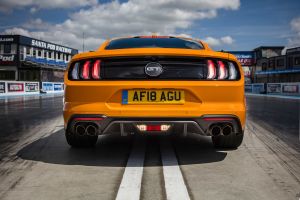
Ford Mustang V8 - full rear static
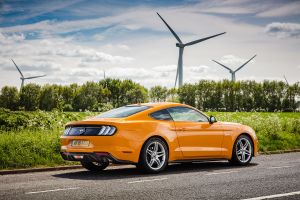
Ford Mustang V8 - rear static
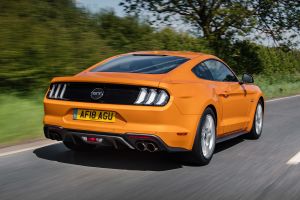
Ford Mustang V8 - rear
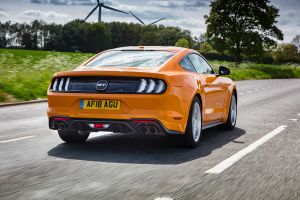
Ford Mustang V8 - rear action
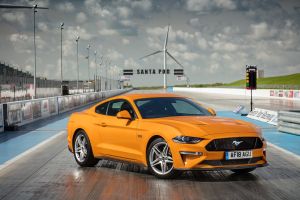
Ford Mustang V8 - front drag strip
Rivals for the four-cylinder Mustang are even scarcer, and include the Audi TT, Toyota GT86 and lower powered-versions of the BMW 2 Series.
The 2018 update gave the Mustang a subtly revised look, but there's still no mistaking the Mustang for what it is. There's a good mix of retro design cues and modern lines, and the car's four-seater interior was given a bit of a refresh, too. There was more power for the V8, up from 412bhp to 444bhp, although curiously the EcoBoost model saw a drop in power, from 313bhp to 286bhp.
Prices saw a hike, too, with the range now starting from around £38,000 for the EcoBoost, and the V8 now in excess of £41,000. On top of that, the special edition Mustang Bullitt (a dark green V8 model inspired by the Steve McQueen car and movie) starts from around £47k.

Ford Mustang V8 - dials

Ford Mustang V8 - rear drag strip

Ford Mustang V8 - front static

Ford Mustang V8 - dash

Ford Mustang V8 - full front static

Ford Mustang V8 - rear profile

Ford Mustang V8 - side static

Ford Mustang V8 - exhaust

Ford Mustang V8 - full front

Ford Mustang V8 - front

Ford Mustang V8 - front light

Ford Mustang V8 - 5.0

Ford Mustang V8 - full rear static

Ford Mustang V8 - rear static

Ford Mustang V8 - rear

Ford Mustang V8 - rear action

Ford Mustang V8 - front drag strip
In 2019 Ford launched the Mustang 55 Edition to celebrate 55 years of Mustang production. The V8-engined model was sold in both coupe and convertible forms for a premium of around £5,000 over the regular Mustang models. The 55 Edition’s engine remained standard, but styling enhancements included special badging, racing stripes, a black roof and an optional rear spoiler. Additions to the standard equipment included an upgraded sound system and temperature-controlled seats.
The EcoBoost model is the sensible pick of the range, although it still has enough performance to entertain, and it's available with either a six-speed manual gearbox or a new 10-speed auto that was also introduced with the 2018 update.
However, it's likely that if you want a Mustang, you'll want the full muscle car experience and the V8 GT model. This too has a six-speed manual and the option of the 10-speed auto, while both engines are available in Fastback coupe and open-top Convertible body styles.
One highlight of the Mustang that makes it more appealing to European tastes is the fact it now comes with independent rear suspension. It replaced the archaic live axle that was fitted in the past, and means the Mustang has good handling that means it's agile and nimble on twisty roads. It also boosts comfort when you're taking it easy.
All Mustangs feature a limited slip differential, selectable driving modes, 19–inch black alloy wheels, Xenon headlamps, a Ford SYNC 3.8-inch touchscreen infotainment system with nine-speaker stereo with DAB and Bluetooth, plus powered seats, mirrors and windows, a rear view camera, keyless entry and dual zone climate control.
The V8 model gets upgraded six-pot brakes, launch control, 19-inch alloys and a bespoke grille and GT badging. The special edition Mustang Bullitt will appeal to those seeking Steve McQueen levels of cool, and comes in Dark Highland Green paint, with a cue-ball gearknob, 'Bullitt' badging and a bit of extra power (all of 14bhp more).
While the UK Mustang range comprises nine models, there are additional options in the US in the form of the powerful Shelby GT350 and GT350R models. These cars boost performance and give them track-focused suspension, tyres and brakes to offer an even sharper drive.
There’s an assumption that V8-powered American sports cars are fast in a straight line and hopeless in the corners, but the Ford Mustang knocks that theory for six. An archaic live rear axle hamstrung previous generations of Mustang, but Ford has engineered the sixth-generation model with independent suspension at all four corners, and the end result is a car that’s satisfying to drive.
UK manual cars feature four selectable driving modes - Normal, Sport+, Track and Snow/Wet - and these adjust the car’s throttle, steering and stability control settings accordingly. In addition, the steering has three levels of resistance, although feedback is a little vague in all modes. With the 2018 facelift, Ford added a configurable My Mode and a new Drag Strip mode setting for the driving selector.
On the road, the car’s suspension soaks up bumps, although the stiff chassis does tend to follow the contours of the road, but overall it’s a comfortable place to be. In town, the small windows limit visibility, but the controls are light enough that the car is easy to manoeuvre, while a reversing camera is fitted as standard to boost rear visibility.
The optional MagnaRide adaptive dampers available with the facelifted Mustang give greater adjustability and fluidity to the Mustang, with the Convertible benefiting significantly from the advantages these convey.
On fast, twisty roads the Mustang performs admirably. It’s well balanced and changes direction quickly, while body roll is kept in check. Get on the power in corners, and the back end will squirm to get the power down, but switch the traction control off completely and you can provoke the car into slides relatively easily, while a smooth power delivery means it’s easy to control, made easier by the standard limited-slip diff.
On the motorway, long gearing in sixth means the V8 is only turning at 1,800rpm at 70mph, so there’s not much engine noise, although tyre roar is noticeable at speed.
Of course, the rumbling 5.0-litre V8 under the bonnet is a big draw for buyers, and its performance doesn’t disappoint. Peak power of 444bhp is made at the 7,000rpm redline, and you have to wind the engine up through the gears to make progress - if you’re pressing on, you don’t need more than third or fourth for the best response, as fifth and sixth are better suited to cruising.
We tested the original V8 in slippery conditions, which meant we could only record a best 0-60mph time of 5.6 seconds. The rear wheels broke traction easily in first and second gear, but Ford’s claimed 0-62mph time of 4.8 seconds seems achievable if it’s dry. The manual shift is short and precise, while a launch control system optimises the car for perfect standing starts.
Ford also includes an electronic Line Lock, which is a piece of electronic trickery sourced from drag racing. The system fully applies the front brakes while allowing the rear tyres to spin up under power, letting you achieve smoky burnouts. The system shuts off after 15 seconds, although that’s still long enough for you to wear out a pair of rear tyres faster than you would in normal use.
Elsewhere, the GT gets six-piston Brembo brakes, and while pedal response is rather sharp, there’s strong power to get the car to a halt quickly. That said, the EcoBoost's standard discs and calipers do a decent job of slowing the hefty Mustang to a halt.

Ford Mustang V8 - dials

Ford Mustang V8 - rear drag strip

Ford Mustang V8 - front static

Ford Mustang V8 - dash

Ford Mustang V8 - full front static

Ford Mustang V8 - rear profile

Ford Mustang V8 - side static

Ford Mustang V8 - exhaust

Ford Mustang V8 - full front

Ford Mustang V8 - front

Ford Mustang V8 - front light

Ford Mustang V8 - 5.0

Ford Mustang V8 - full rear static

Ford Mustang V8 - rear static

Ford Mustang V8 - rear

Ford Mustang V8 - rear action

Ford Mustang V8 - front drag strip
While the 10-speed automatic gearbox of the facelifted Mustang is better than the six-speed unit it replaces, the manual transmission is still the box to go for. As a traditional torque converter unit, the new auto doesn't have the immediacy offered by a dual-clutch setup, with downshifts in particular lacking the urgency one might expect.
The 5.0-litre V8 is the flagship of the range, and it makes 444bhp at 7,000rpm, so you need to rev it to make the most of its performance. There’s also 533Nm of torque on offer, and the broad spread of power means it’s possible to trundle along at 30mph in sixth gear with the engine turning at 750rpm without any trouble.
The 286bhp 2.3-litre turbo EcoBoost engine is punchy, even if it’s not as fast as the V8. Some buyers might appreciate the extra economy you get without sacrificing too much performance, though. The EcoBoost feels a little lethargic off the line as it struggle to overcome the Mustang's near 1,700kg kerbweight, but once the turbo is pumping at around 2,000rpm, it feels nearly as quick as the V8 car. It's just a shame it doesn't sound as good.
Like the latest generation of BMW M cars, the Mustang gets a sound symposer that uses the stereo to deliver a more sporty soundtrack. The resulting growl certainly sounds racier than the four-cylinder unit’s natural drone, but there's no escaping the fact that it's a synthesized engine note.
As it is, around 70 per cent of UK buyers are going for the V8 model, attracted not only by its performance, but also its V8 rumble. It sounds good, although it’s not as loud as a Jaguar F-Type, for example.
The facelifted Mustang range is priced in the £38-£48k bracket, which is a hike of around £3,000 over the 2015 original, and substantially more than it costs in the US. However, it’s still good value when compared to rivals. The 5.0 GT is the cheapest V8 car on sale in the UK, and by some margin, but it’s also well equipped, with leather, climate control, a limited-slip diff, xenon lights and DAB radio all included. The only options are an upgraded infotainment system with sat-nav, heated and cooled seats, rear parking sensors, and a Custom Pack, which adds all of this and silver wheels, but even this won’t break the bank at £1,800.
If you want a car with a V8 engine, then the next cheapest rival option used to be the Vauxhall VXR8, but this is no longer offered. If you want a V8 coupe, then you’re looking at the Lexus RC F, although it’s arguable that the Mustang is more enjoyable to drive. In contrast, the 2.3 EcoBoost model is priced to match models such as the Audi TT 2.0 TFSI Sport, although the Ford is bigger than just about every other car in this class.

Ford Mustang V8 - dials

Ford Mustang V8 - rear drag strip

Ford Mustang V8 - front static

Ford Mustang V8 - dash

Ford Mustang V8 - full front static

Ford Mustang V8 - rear profile

Ford Mustang V8 - side static

Ford Mustang V8 - exhaust

Ford Mustang V8 - full front

Ford Mustang V8 - front

Ford Mustang V8 - front light

Ford Mustang V8 - 5.0

Ford Mustang V8 - full rear static

Ford Mustang V8 - rear static

Ford Mustang V8 - rear

Ford Mustang V8 - rear action

Ford Mustang V8 - front drag strip
The big blot on the Mustang’s copybook is the expense of running a 5.0-litre V8. There’s no stop-start, so economy of 22.8mpg is the quoted figure for a manual model. The lack of eco systems means emissions at 278g/km for a V8 coupe with a manual gearbox, resulting in a first-year VED rate of £2,135, followed by £145 from year two. All Mustangs costing over £40,000 are liable for an additional £320 tax supplement that runs for five years, starting in year two of ownership.
The EcoBoost is better, with claimed economy of 31.3mpg and emissions of 204g/km for the coupe and 209g/km for the convertible, but that’s still behind the Audi TT and BMW 2 Series. Add an auto box to either the V8 or the EcoBoost and emissions are made worse on the latter, but the V8 is slightly better - although that doesn’t improve road tax or company car costs. You get a 61-litre fuel tank in the Mustang, which means you’ll get a range of around 270 miles in the V8 model.
The Mustang sits in insurance groups 41-46, which is on the high side, but then if you’re happy to stump up the fuel and tax costs, then it probably won’t be too much of a concern. The V8 has the same Group 43 rating as the EcoBoost Convertible, which is lower than for rival V8 models.
One useful feature is Ford’s MyKey function, which allows you to set controls and functions to limit who can use the car, including setting a speed limiter.
Our experts predict decent residuals of between 48-53 per cent for the Mustang after three years.
American cars have a reputation for being big and bold, and the Mustang doesn’t disappoint. The four-seater coupé is nearly as long as a Mondeo, but the low roof and wide track provide a sporty look.
It’s an evolution of the last model, yet while there are retro cues to the design, it still looks modern. Up front is a large grille with a galloping horse logo in the middle, while the small light housings either side emphasise the imposing front end.
A pair of sculpted lines rise from the long bonnet, and the blistered wheelarches add to the muscular look. There’s a low roof and small glass area, while the Fastback rear barely deviates from horizontal.

Ford Mustang V8 - dials

Ford Mustang V8 - rear drag strip

Ford Mustang V8 - front static

Ford Mustang V8 - dash

Ford Mustang V8 - full front static

Ford Mustang V8 - rear profile

Ford Mustang V8 - side static

Ford Mustang V8 - exhaust

Ford Mustang V8 - full front

Ford Mustang V8 - front

Ford Mustang V8 - front light

Ford Mustang V8 - 5.0

Ford Mustang V8 - full rear static

Ford Mustang V8 - rear static

Ford Mustang V8 - rear

Ford Mustang V8 - rear action

Ford Mustang V8 - front drag strip
The tail-lights are set into a black panel with a big GT badge in the middle – a nod to the sixties Mustang – but lower down the body-coloured section in the rear diffuser is similar to the Fiesta ST’s. The V8 gets black 19-inch multispoke alloy wheels as standard, while going for the Custom Pack adds silver wheels in the same design, plus silver trim for the windows.
Everywhere we you go, the Ford will turn heads, with its kerb appeal certainly matching a Jaguar F-Type. Distinctive Triple Coat Yellow paint is an option costing around £800, but even opting for standard red or orange will make an impact. Metallics include a vivid blue and a dark green to match Steve McQueen’s Mustang in the movie Bullitt. You could even go the whole hog and order the Bullitt special edition, which features this Highland Green paint, together with a cue ball-style gearknob, an upgraded stereo and an extra 14bhp.
Climb inside, and there are more retro touches. The three-spoke steering wheel has a silver finish and a chrome-ringed Mustang logo, although the multitude of buttons on the wheel adds a hint of modernity to it. A swathe of silver plastic covers the dash, and there’s a ‘Since 1964’ plaque on the passenger’s side of the upright dash, while the rotary volume and tuner controls create a nostalgic feel.
The rocker switches for the temperature controls are a bit fiddly to use, while the bank of toggle switches beneath the climate buttons are another nod to the sixties car, although again the big, red-ringed starter button adds a modern touch to the controls. Ahead of the driver there’s a pair of deep cowled instruments – the speedo has the legend ‘Ground Speed’ emblazoned upon it – and between them is a full colour trip computer display that shows a comprehensive amount of information.
Unfortunately, it’s the interior that gives away the Mustang’s budget roots, and some of the cabin plastics feel cheap. The silver trim on the dash looks a bit low-rent, while hard plastics are used for the glovebox, centre console, door trims and the overhead light switches.
Interior quality took a step up when the 2018 facelift arrived, though, partly thanks to the addition of some new soft-touch interior plastics. The analogue dashboard dials were also replaced, with a 12-inch digital screen standing in their place as standard.
And whatever your thoughts are on the facelift's aesthetic changes, the new lights, bumpers, wheels and exhausts, plus the lower bonnet and sharper grille, give the 2018 car a look that's clearly different from the model it replaces.
The Mustang comes with Ford’s latest infotainment system, which, in facelifted cars, means you get its eight-inch Sync 3 system - though sat-nav is an option that’s included when you add the optional Shaker 10-speaker stereo system.

Ford Mustang V8 - dials

Ford Mustang V8 - rear drag strip

Ford Mustang V8 - front static

Ford Mustang V8 - dash

Ford Mustang V8 - full front static

Ford Mustang V8 - rear profile

Ford Mustang V8 - side static

Ford Mustang V8 - exhaust

Ford Mustang V8 - full front

Ford Mustang V8 - front

Ford Mustang V8 - front light

Ford Mustang V8 - 5.0

Ford Mustang V8 - full rear static

Ford Mustang V8 - rear static

Ford Mustang V8 - rear

Ford Mustang V8 - rear action

Ford Mustang V8 - front drag strip
New for the 2018 facelift is a standard 12-inch digital dashboard. While some might miss traditional 'clocks', the digital dash looks great, and changes its display based on the selected driving mode.
Bluetooth, DAB radio and a USB socket are all standard, and so is Ford’s advanced Sync voice control system. This allows you to make hands-free adjustments to the radio, phone and climate controls by pressing a button on the steering wheel to speak your instructions.
Pairing a phone to make calls and stream audio is a straightforward process, and you can set one phone as your favourite to automatically connect every time you get on board.
The optional Shaker sound system adds a subwoofer that’s set into the side of the boot behind the offside rear wheel. It doesn’t really reduce boot space, and adds some extra bass to the sound system, for those times when you’re bored of listening to the Mustang’s V8. Although if you get tired of that, then you have no soul and this isn’t the car for you.
The Mustang is reasonably practical for a sports car. It’s a long car, but that means there’s room for a pair of back seats and a reasonably sized boot. There’s more space than you’ll find in an Audi TT, although access to the boot is a bit trickier thanks to the narrow opening of the saloon-style bootlid.
At 4.8 metres long, the Mustang is nearly the same length as the five-door Ford Mondeo (4.87 metres), but it’s not as wide and a lot lower. Compared to rivals such as the BMW 2 Series and Audi TT, the Mustang is a fair bit larger, but that does mean there’s more space inside.
The suspension has been set up to deliver a good mix between handling and comfort, and unlike some rivals, the ride height is set so that the car doesn’t scrape over speed bumps.

Ford Mustang V8 - dials

Ford Mustang V8 - rear drag strip

Ford Mustang V8 - front static

Ford Mustang V8 - dash

Ford Mustang V8 - full front static

Ford Mustang V8 - rear profile

Ford Mustang V8 - side static

Ford Mustang V8 - exhaust

Ford Mustang V8 - full front

Ford Mustang V8 - front

Ford Mustang V8 - front light

Ford Mustang V8 - 5.0

Ford Mustang V8 - full rear static

Ford Mustang V8 - rear static

Ford Mustang V8 - rear

Ford Mustang V8 - rear action

Ford Mustang V8 - front drag strip
Up front, access is easy thanks to the wide opening doors. At night, Mustang logos are projected on the floor by the puddle lights in the wing mirrors. There’s plenty of space inside and no issues with head or legroom, while a wide range of wheel and seat adjustment means it’s easy to get comfortable at the wheel. Forward visibility is compromised slightly by the long, bulging bonnet – it would be nice if Ford offered front parking sensors, but they aren’t available. The thick rear pillars and narrow rear glass limit the rear view, but a standard-fit reversing camera is a helpful addition.
There isn’t much leg or headroom in the back seats, so they’re only really suitable for small children. However, there is more space in the back than you’ll find in similarly sized coupes, like the Nissan GT-R. The back seats feature Isofix child seat mounts, but adding a child seat is tricky because access to the back seats is tight behind the folded front seats. And if you have fitted a child seat, legroom is reduced even further.
The back seats fold 50:50 to improve boot space, which measures 408 litres in regular use. A high load lip and narrow opening thanks to the saloon-style bootlid make access to the boot tricky, but you can fit in a couple of medium sized suitcases pretty easily. There are no lashing eyes, but there is additional storage under the boot floor in the spare wheel well around the standard tyre repair kit.
The boot can be opened via a button above the number plate, with two presses of the keyfob, or via a flimsy button on the dashboard.
Cabin storage is reasonable for a sports car. The door bins are pretty good, and there’s a decent-sized glovebox, while the small armrest cubby is supplemented by a pair of deep cup-holders, although even a canned drink can get in the way as you reach for the gearlever.
Ford has fitted a raft of electronic driver aids to keep the Mustang on the straight and narrow. There’s a multi-stage traction control system with different settings for road or track use, while the V8 GT model gets six-piston Brembo brakes for improved stopping power.
All models get a full set of airbags, while a pedestrian-friendly pop-up bonnet boosts safety. The back seats come with Isofix mounts for child seats, too. In January 2017, the Ford Mustang hit the headlines for all the wrong reasons, when it was awarded a lowly two stars in the Euro NCAP crash safety test. While the Mustang gets a 72 per cent rating for adult occupant protection, the cause for concern regards protection for child occupants and the lack of the safety equipment.

Ford Mustang V8 - dials

Ford Mustang V8 - rear drag strip

Ford Mustang V8 - front static

Ford Mustang V8 - dash

Ford Mustang V8 - full front static

Ford Mustang V8 - rear profile

Ford Mustang V8 - side static

Ford Mustang V8 - exhaust

Ford Mustang V8 - full front

Ford Mustang V8 - front

Ford Mustang V8 - front light

Ford Mustang V8 - 5.0

Ford Mustang V8 - full rear static

Ford Mustang V8 - rear static

Ford Mustang V8 - rear

Ford Mustang V8 - rear action

Ford Mustang V8 - front drag strip
Later in the year, the facelifted Mustang was re-tested in a bid to improve its score. Changes to the frontal airbags and the addition of autonomous emergency braking and lane assistance as standard delivers a three-star rating.
In terms of build quality, the Mustang feels well built, even if the materials used aren’t of the highest quality. And, while it sells in too few numbers to have featured in our 2020 Driver Power Customer satisfaction survey, Ford as a company finished in 24th position out of 30 manufacturers.
Like every new Ford, the Mustang comes with a three-year, 60,000-mile warranty, which is backed up by one-year’s breakdown assistance. That’s fairly average, and no better or worse than rivals which offer similar coverage.
Ford has yet to confirm servicing costs for the Mustang, but you can expect them to be cheaper than they are for premium rivals. Add in Ford’s vast dealer network, and it should be pretty easy to get the car maintained on schedule. Service intervals are every 12 months or 10,000 miles, which is a shorter distance between dealer visits than it is for some rivals.
For an alternative review of the latest Ford Mustang Coupe visit our sister site carbuyer.co.uk
Continue reading...
There are some drawbacks of course: some of the interior materials are a little cheap (although an update in 2018 improved this) and the engines are extremely thirsty, but it’s hard to complain when prices start from as little as £38,000. The EcoBoost engine isn’t quite as dramatic or fast as its V8 sibling, but the difference isn’t that pronounced and it does at least cut running costs.
Few other vehicles are as eye-catching as the Mustang at this price point, nor can they offer as much engine grunt.
• Ford Mustang Convertible review
About the Ford Mustang
The Ford Mustang has been on sale in the UK since the latter stages of 2015, although the iconic Mustang name has existed in one form or another since the middle of the 1960s. The current model is the sixth-generation Mustang and is offered as a Fastback coupe or fabric-roofed convertible, offered in either 5.0-litre V8 GT or 2.3-litre EcoBoost guise. This line-up has helped the Mustang to become an instant hit with buyers, while an update in 2018 has helped it to maintain its appeal. A retro Mustang Bullitt model sits at the top of the range, inspired by the car that featured in the famous film of the same name.
There aren't really many rivals for the Ford Mustang in the UK. Its arch rival in the US is the Chevrolet Camaro, available here as a special order model in left-hand-drive only, so the Mustang has the market pretty much to itself. The Lexus RC F is a V8 coupe, but it's around £20,000 more expensive than the Ford, while the harder-edged BMW M2 Competition sits just above the top-spec Bullitt Mustang in the market, priced at around £50,000. The Toyota Supra is a better all-round sports car but is priced to take on pricier rivals like the Porsche Cayman.

Ford Mustang V8 - dials

Ford Mustang V8 - rear drag strip

Ford Mustang V8 - front static

Ford Mustang V8 - dash

Ford Mustang V8 - full front static

Ford Mustang V8 - rear profile

Ford Mustang V8 - side static

Ford Mustang V8 - exhaust

Ford Mustang V8 - full front

Ford Mustang V8 - front

Ford Mustang V8 - front light

Ford Mustang V8 - 5.0

Ford Mustang V8 - full rear static

Ford Mustang V8 - rear static

Ford Mustang V8 - rear

Ford Mustang V8 - rear action

Ford Mustang V8 - front drag strip
Rivals for the four-cylinder Mustang are even scarcer, and include the Audi TT, Toyota GT86 and lower powered-versions of the BMW 2 Series.
The 2018 update gave the Mustang a subtly revised look, but there's still no mistaking the Mustang for what it is. There's a good mix of retro design cues and modern lines, and the car's four-seater interior was given a bit of a refresh, too. There was more power for the V8, up from 412bhp to 444bhp, although curiously the EcoBoost model saw a drop in power, from 313bhp to 286bhp.
Prices saw a hike, too, with the range now starting from around £38,000 for the EcoBoost, and the V8 now in excess of £41,000. On top of that, the special edition Mustang Bullitt (a dark green V8 model inspired by the Steve McQueen car and movie) starts from around £47k.

Ford Mustang V8 - dials

Ford Mustang V8 - rear drag strip

Ford Mustang V8 - front static

Ford Mustang V8 - dash

Ford Mustang V8 - full front static

Ford Mustang V8 - rear profile

Ford Mustang V8 - side static

Ford Mustang V8 - exhaust

Ford Mustang V8 - full front

Ford Mustang V8 - front

Ford Mustang V8 - front light

Ford Mustang V8 - 5.0

Ford Mustang V8 - full rear static

Ford Mustang V8 - rear static

Ford Mustang V8 - rear

Ford Mustang V8 - rear action

Ford Mustang V8 - front drag strip
In 2019 Ford launched the Mustang 55 Edition to celebrate 55 years of Mustang production. The V8-engined model was sold in both coupe and convertible forms for a premium of around £5,000 over the regular Mustang models. The 55 Edition’s engine remained standard, but styling enhancements included special badging, racing stripes, a black roof and an optional rear spoiler. Additions to the standard equipment included an upgraded sound system and temperature-controlled seats.
The EcoBoost model is the sensible pick of the range, although it still has enough performance to entertain, and it's available with either a six-speed manual gearbox or a new 10-speed auto that was also introduced with the 2018 update.
However, it's likely that if you want a Mustang, you'll want the full muscle car experience and the V8 GT model. This too has a six-speed manual and the option of the 10-speed auto, while both engines are available in Fastback coupe and open-top Convertible body styles.
One highlight of the Mustang that makes it more appealing to European tastes is the fact it now comes with independent rear suspension. It replaced the archaic live axle that was fitted in the past, and means the Mustang has good handling that means it's agile and nimble on twisty roads. It also boosts comfort when you're taking it easy.
All Mustangs feature a limited slip differential, selectable driving modes, 19–inch black alloy wheels, Xenon headlamps, a Ford SYNC 3.8-inch touchscreen infotainment system with nine-speaker stereo with DAB and Bluetooth, plus powered seats, mirrors and windows, a rear view camera, keyless entry and dual zone climate control.
The V8 model gets upgraded six-pot brakes, launch control, 19-inch alloys and a bespoke grille and GT badging. The special edition Mustang Bullitt will appeal to those seeking Steve McQueen levels of cool, and comes in Dark Highland Green paint, with a cue-ball gearknob, 'Bullitt' badging and a bit of extra power (all of 14bhp more).
While the UK Mustang range comprises nine models, there are additional options in the US in the form of the powerful Shelby GT350 and GT350R models. These cars boost performance and give them track-focused suspension, tyres and brakes to offer an even sharper drive.
There’s an assumption that V8-powered American sports cars are fast in a straight line and hopeless in the corners, but the Ford Mustang knocks that theory for six. An archaic live rear axle hamstrung previous generations of Mustang, but Ford has engineered the sixth-generation model with independent suspension at all four corners, and the end result is a car that’s satisfying to drive.
UK manual cars feature four selectable driving modes - Normal, Sport+, Track and Snow/Wet - and these adjust the car’s throttle, steering and stability control settings accordingly. In addition, the steering has three levels of resistance, although feedback is a little vague in all modes. With the 2018 facelift, Ford added a configurable My Mode and a new Drag Strip mode setting for the driving selector.
On the road, the car’s suspension soaks up bumps, although the stiff chassis does tend to follow the contours of the road, but overall it’s a comfortable place to be. In town, the small windows limit visibility, but the controls are light enough that the car is easy to manoeuvre, while a reversing camera is fitted as standard to boost rear visibility.
The optional MagnaRide adaptive dampers available with the facelifted Mustang give greater adjustability and fluidity to the Mustang, with the Convertible benefiting significantly from the advantages these convey.
On fast, twisty roads the Mustang performs admirably. It’s well balanced and changes direction quickly, while body roll is kept in check. Get on the power in corners, and the back end will squirm to get the power down, but switch the traction control off completely and you can provoke the car into slides relatively easily, while a smooth power delivery means it’s easy to control, made easier by the standard limited-slip diff.
On the motorway, long gearing in sixth means the V8 is only turning at 1,800rpm at 70mph, so there’s not much engine noise, although tyre roar is noticeable at speed.
Of course, the rumbling 5.0-litre V8 under the bonnet is a big draw for buyers, and its performance doesn’t disappoint. Peak power of 444bhp is made at the 7,000rpm redline, and you have to wind the engine up through the gears to make progress - if you’re pressing on, you don’t need more than third or fourth for the best response, as fifth and sixth are better suited to cruising.
We tested the original V8 in slippery conditions, which meant we could only record a best 0-60mph time of 5.6 seconds. The rear wheels broke traction easily in first and second gear, but Ford’s claimed 0-62mph time of 4.8 seconds seems achievable if it’s dry. The manual shift is short and precise, while a launch control system optimises the car for perfect standing starts.
Ford also includes an electronic Line Lock, which is a piece of electronic trickery sourced from drag racing. The system fully applies the front brakes while allowing the rear tyres to spin up under power, letting you achieve smoky burnouts. The system shuts off after 15 seconds, although that’s still long enough for you to wear out a pair of rear tyres faster than you would in normal use.
Elsewhere, the GT gets six-piston Brembo brakes, and while pedal response is rather sharp, there’s strong power to get the car to a halt quickly. That said, the EcoBoost's standard discs and calipers do a decent job of slowing the hefty Mustang to a halt.

Ford Mustang V8 - dials

Ford Mustang V8 - rear drag strip

Ford Mustang V8 - front static

Ford Mustang V8 - dash

Ford Mustang V8 - full front static

Ford Mustang V8 - rear profile

Ford Mustang V8 - side static

Ford Mustang V8 - exhaust

Ford Mustang V8 - full front

Ford Mustang V8 - front

Ford Mustang V8 - front light

Ford Mustang V8 - 5.0

Ford Mustang V8 - full rear static

Ford Mustang V8 - rear static

Ford Mustang V8 - rear

Ford Mustang V8 - rear action

Ford Mustang V8 - front drag strip
While the 10-speed automatic gearbox of the facelifted Mustang is better than the six-speed unit it replaces, the manual transmission is still the box to go for. As a traditional torque converter unit, the new auto doesn't have the immediacy offered by a dual-clutch setup, with downshifts in particular lacking the urgency one might expect.
Engines
The 5.0-litre V8 is the flagship of the range, and it makes 444bhp at 7,000rpm, so you need to rev it to make the most of its performance. There’s also 533Nm of torque on offer, and the broad spread of power means it’s possible to trundle along at 30mph in sixth gear with the engine turning at 750rpm without any trouble.
The 286bhp 2.3-litre turbo EcoBoost engine is punchy, even if it’s not as fast as the V8. Some buyers might appreciate the extra economy you get without sacrificing too much performance, though. The EcoBoost feels a little lethargic off the line as it struggle to overcome the Mustang's near 1,700kg kerbweight, but once the turbo is pumping at around 2,000rpm, it feels nearly as quick as the V8 car. It's just a shame it doesn't sound as good.
Like the latest generation of BMW M cars, the Mustang gets a sound symposer that uses the stereo to deliver a more sporty soundtrack. The resulting growl certainly sounds racier than the four-cylinder unit’s natural drone, but there's no escaping the fact that it's a synthesized engine note.
As it is, around 70 per cent of UK buyers are going for the V8 model, attracted not only by its performance, but also its V8 rumble. It sounds good, although it’s not as loud as a Jaguar F-Type, for example.
The facelifted Mustang range is priced in the £38-£48k bracket, which is a hike of around £3,000 over the 2015 original, and substantially more than it costs in the US. However, it’s still good value when compared to rivals. The 5.0 GT is the cheapest V8 car on sale in the UK, and by some margin, but it’s also well equipped, with leather, climate control, a limited-slip diff, xenon lights and DAB radio all included. The only options are an upgraded infotainment system with sat-nav, heated and cooled seats, rear parking sensors, and a Custom Pack, which adds all of this and silver wheels, but even this won’t break the bank at £1,800.
If you want a car with a V8 engine, then the next cheapest rival option used to be the Vauxhall VXR8, but this is no longer offered. If you want a V8 coupe, then you’re looking at the Lexus RC F, although it’s arguable that the Mustang is more enjoyable to drive. In contrast, the 2.3 EcoBoost model is priced to match models such as the Audi TT 2.0 TFSI Sport, although the Ford is bigger than just about every other car in this class.

Ford Mustang V8 - dials

Ford Mustang V8 - rear drag strip

Ford Mustang V8 - front static

Ford Mustang V8 - dash

Ford Mustang V8 - full front static

Ford Mustang V8 - rear profile

Ford Mustang V8 - side static

Ford Mustang V8 - exhaust

Ford Mustang V8 - full front

Ford Mustang V8 - front

Ford Mustang V8 - front light

Ford Mustang V8 - 5.0

Ford Mustang V8 - full rear static

Ford Mustang V8 - rear static

Ford Mustang V8 - rear

Ford Mustang V8 - rear action

Ford Mustang V8 - front drag strip
The big blot on the Mustang’s copybook is the expense of running a 5.0-litre V8. There’s no stop-start, so economy of 22.8mpg is the quoted figure for a manual model. The lack of eco systems means emissions at 278g/km for a V8 coupe with a manual gearbox, resulting in a first-year VED rate of £2,135, followed by £145 from year two. All Mustangs costing over £40,000 are liable for an additional £320 tax supplement that runs for five years, starting in year two of ownership.
The EcoBoost is better, with claimed economy of 31.3mpg and emissions of 204g/km for the coupe and 209g/km for the convertible, but that’s still behind the Audi TT and BMW 2 Series. Add an auto box to either the V8 or the EcoBoost and emissions are made worse on the latter, but the V8 is slightly better - although that doesn’t improve road tax or company car costs. You get a 61-litre fuel tank in the Mustang, which means you’ll get a range of around 270 miles in the V8 model.
Insurance groups
The Mustang sits in insurance groups 41-46, which is on the high side, but then if you’re happy to stump up the fuel and tax costs, then it probably won’t be too much of a concern. The V8 has the same Group 43 rating as the EcoBoost Convertible, which is lower than for rival V8 models.
One useful feature is Ford’s MyKey function, which allows you to set controls and functions to limit who can use the car, including setting a speed limiter.
Depreciation
Our experts predict decent residuals of between 48-53 per cent for the Mustang after three years.
American cars have a reputation for being big and bold, and the Mustang doesn’t disappoint. The four-seater coupé is nearly as long as a Mondeo, but the low roof and wide track provide a sporty look.
It’s an evolution of the last model, yet while there are retro cues to the design, it still looks modern. Up front is a large grille with a galloping horse logo in the middle, while the small light housings either side emphasise the imposing front end.
A pair of sculpted lines rise from the long bonnet, and the blistered wheelarches add to the muscular look. There’s a low roof and small glass area, while the Fastback rear barely deviates from horizontal.

Ford Mustang V8 - dials

Ford Mustang V8 - rear drag strip

Ford Mustang V8 - front static

Ford Mustang V8 - dash

Ford Mustang V8 - full front static

Ford Mustang V8 - rear profile

Ford Mustang V8 - side static

Ford Mustang V8 - exhaust

Ford Mustang V8 - full front

Ford Mustang V8 - front

Ford Mustang V8 - front light

Ford Mustang V8 - 5.0

Ford Mustang V8 - full rear static

Ford Mustang V8 - rear static

Ford Mustang V8 - rear

Ford Mustang V8 - rear action

Ford Mustang V8 - front drag strip
The tail-lights are set into a black panel with a big GT badge in the middle – a nod to the sixties Mustang – but lower down the body-coloured section in the rear diffuser is similar to the Fiesta ST’s. The V8 gets black 19-inch multispoke alloy wheels as standard, while going for the Custom Pack adds silver wheels in the same design, plus silver trim for the windows.
Everywhere we you go, the Ford will turn heads, with its kerb appeal certainly matching a Jaguar F-Type. Distinctive Triple Coat Yellow paint is an option costing around £800, but even opting for standard red or orange will make an impact. Metallics include a vivid blue and a dark green to match Steve McQueen’s Mustang in the movie Bullitt. You could even go the whole hog and order the Bullitt special edition, which features this Highland Green paint, together with a cue ball-style gearknob, an upgraded stereo and an extra 14bhp.
Climb inside, and there are more retro touches. The three-spoke steering wheel has a silver finish and a chrome-ringed Mustang logo, although the multitude of buttons on the wheel adds a hint of modernity to it. A swathe of silver plastic covers the dash, and there’s a ‘Since 1964’ plaque on the passenger’s side of the upright dash, while the rotary volume and tuner controls create a nostalgic feel.
The rocker switches for the temperature controls are a bit fiddly to use, while the bank of toggle switches beneath the climate buttons are another nod to the sixties car, although again the big, red-ringed starter button adds a modern touch to the controls. Ahead of the driver there’s a pair of deep cowled instruments – the speedo has the legend ‘Ground Speed’ emblazoned upon it – and between them is a full colour trip computer display that shows a comprehensive amount of information.
Unfortunately, it’s the interior that gives away the Mustang’s budget roots, and some of the cabin plastics feel cheap. The silver trim on the dash looks a bit low-rent, while hard plastics are used for the glovebox, centre console, door trims and the overhead light switches.
Interior quality took a step up when the 2018 facelift arrived, though, partly thanks to the addition of some new soft-touch interior plastics. The analogue dashboard dials were also replaced, with a 12-inch digital screen standing in their place as standard.
And whatever your thoughts are on the facelift's aesthetic changes, the new lights, bumpers, wheels and exhausts, plus the lower bonnet and sharper grille, give the 2018 car a look that's clearly different from the model it replaces.
Sat-nav, stereo and infotainment
The Mustang comes with Ford’s latest infotainment system, which, in facelifted cars, means you get its eight-inch Sync 3 system - though sat-nav is an option that’s included when you add the optional Shaker 10-speaker stereo system.

Ford Mustang V8 - dials

Ford Mustang V8 - rear drag strip

Ford Mustang V8 - front static

Ford Mustang V8 - dash

Ford Mustang V8 - full front static

Ford Mustang V8 - rear profile

Ford Mustang V8 - side static

Ford Mustang V8 - exhaust

Ford Mustang V8 - full front

Ford Mustang V8 - front

Ford Mustang V8 - front light

Ford Mustang V8 - 5.0

Ford Mustang V8 - full rear static

Ford Mustang V8 - rear static

Ford Mustang V8 - rear

Ford Mustang V8 - rear action

Ford Mustang V8 - front drag strip
New for the 2018 facelift is a standard 12-inch digital dashboard. While some might miss traditional 'clocks', the digital dash looks great, and changes its display based on the selected driving mode.
Bluetooth, DAB radio and a USB socket are all standard, and so is Ford’s advanced Sync voice control system. This allows you to make hands-free adjustments to the radio, phone and climate controls by pressing a button on the steering wheel to speak your instructions.
Pairing a phone to make calls and stream audio is a straightforward process, and you can set one phone as your favourite to automatically connect every time you get on board.
The optional Shaker sound system adds a subwoofer that’s set into the side of the boot behind the offside rear wheel. It doesn’t really reduce boot space, and adds some extra bass to the sound system, for those times when you’re bored of listening to the Mustang’s V8. Although if you get tired of that, then you have no soul and this isn’t the car for you.
The Mustang is reasonably practical for a sports car. It’s a long car, but that means there’s room for a pair of back seats and a reasonably sized boot. There’s more space than you’ll find in an Audi TT, although access to the boot is a bit trickier thanks to the narrow opening of the saloon-style bootlid.
Size
At 4.8 metres long, the Mustang is nearly the same length as the five-door Ford Mondeo (4.87 metres), but it’s not as wide and a lot lower. Compared to rivals such as the BMW 2 Series and Audi TT, the Mustang is a fair bit larger, but that does mean there’s more space inside.
The suspension has been set up to deliver a good mix between handling and comfort, and unlike some rivals, the ride height is set so that the car doesn’t scrape over speed bumps.

Ford Mustang V8 - dials

Ford Mustang V8 - rear drag strip

Ford Mustang V8 - front static

Ford Mustang V8 - dash

Ford Mustang V8 - full front static

Ford Mustang V8 - rear profile

Ford Mustang V8 - side static

Ford Mustang V8 - exhaust

Ford Mustang V8 - full front

Ford Mustang V8 - front

Ford Mustang V8 - front light

Ford Mustang V8 - 5.0

Ford Mustang V8 - full rear static

Ford Mustang V8 - rear static

Ford Mustang V8 - rear

Ford Mustang V8 - rear action

Ford Mustang V8 - front drag strip
Leg room, head room & passenger space
Up front, access is easy thanks to the wide opening doors. At night, Mustang logos are projected on the floor by the puddle lights in the wing mirrors. There’s plenty of space inside and no issues with head or legroom, while a wide range of wheel and seat adjustment means it’s easy to get comfortable at the wheel. Forward visibility is compromised slightly by the long, bulging bonnet – it would be nice if Ford offered front parking sensors, but they aren’t available. The thick rear pillars and narrow rear glass limit the rear view, but a standard-fit reversing camera is a helpful addition.
There isn’t much leg or headroom in the back seats, so they’re only really suitable for small children. However, there is more space in the back than you’ll find in similarly sized coupes, like the Nissan GT-R. The back seats feature Isofix child seat mounts, but adding a child seat is tricky because access to the back seats is tight behind the folded front seats. And if you have fitted a child seat, legroom is reduced even further.
Boot
The back seats fold 50:50 to improve boot space, which measures 408 litres in regular use. A high load lip and narrow opening thanks to the saloon-style bootlid make access to the boot tricky, but you can fit in a couple of medium sized suitcases pretty easily. There are no lashing eyes, but there is additional storage under the boot floor in the spare wheel well around the standard tyre repair kit.
The boot can be opened via a button above the number plate, with two presses of the keyfob, or via a flimsy button on the dashboard.
Cabin storage is reasonable for a sports car. The door bins are pretty good, and there’s a decent-sized glovebox, while the small armrest cubby is supplemented by a pair of deep cup-holders, although even a canned drink can get in the way as you reach for the gearlever.
Ford has fitted a raft of electronic driver aids to keep the Mustang on the straight and narrow. There’s a multi-stage traction control system with different settings for road or track use, while the V8 GT model gets six-piston Brembo brakes for improved stopping power.
All models get a full set of airbags, while a pedestrian-friendly pop-up bonnet boosts safety. The back seats come with Isofix mounts for child seats, too. In January 2017, the Ford Mustang hit the headlines for all the wrong reasons, when it was awarded a lowly two stars in the Euro NCAP crash safety test. While the Mustang gets a 72 per cent rating for adult occupant protection, the cause for concern regards protection for child occupants and the lack of the safety equipment.

Ford Mustang V8 - dials

Ford Mustang V8 - rear drag strip

Ford Mustang V8 - front static

Ford Mustang V8 - dash

Ford Mustang V8 - full front static

Ford Mustang V8 - rear profile

Ford Mustang V8 - side static

Ford Mustang V8 - exhaust

Ford Mustang V8 - full front

Ford Mustang V8 - front

Ford Mustang V8 - front light

Ford Mustang V8 - 5.0

Ford Mustang V8 - full rear static

Ford Mustang V8 - rear static

Ford Mustang V8 - rear

Ford Mustang V8 - rear action

Ford Mustang V8 - front drag strip
Later in the year, the facelifted Mustang was re-tested in a bid to improve its score. Changes to the frontal airbags and the addition of autonomous emergency braking and lane assistance as standard delivers a three-star rating.
In terms of build quality, the Mustang feels well built, even if the materials used aren’t of the highest quality. And, while it sells in too few numbers to have featured in our 2020 Driver Power Customer satisfaction survey, Ford as a company finished in 24th position out of 30 manufacturers.
Warranty
Like every new Ford, the Mustang comes with a three-year, 60,000-mile warranty, which is backed up by one-year’s breakdown assistance. That’s fairly average, and no better or worse than rivals which offer similar coverage.
Servicing
Ford has yet to confirm servicing costs for the Mustang, but you can expect them to be cheaper than they are for premium rivals. Add in Ford’s vast dealer network, and it should be pretty easy to get the car maintained on schedule. Service intervals are every 12 months or 10,000 miles, which is a shorter distance between dealer visits than it is for some rivals.
For an alternative review of the latest Ford Mustang Coupe visit our sister site carbuyer.co.uk
Continue reading...
